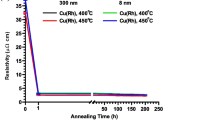Abstract
The use of soft solders, particularly those containing lead, dates back nearly 5,000 years. Solders similar to the materials used to seal the aqueducts of ancient Rome are now an important building block in the manufacture of high-speed computer assemblies. This history attests to the technological versatility of soft solders and, in particular, the solder alloys that contain lead. However, the health effects of prolonged exposure to lead have also been documented; measures to limit human exposure—at the work place and indirectly through the environment—are being considered. The successful introduction of lead-free solders into future electronic products will rely heavily upon their solderability, which can be evaluated by test procedures such as the meniscometer/wetting balance technique and the capillary flow test.
Similar content being viewed by others
References
J. Wolters, “Zur Geschichte der Lottechnik” (Frankfurt, Germany: Degussa, 1978).
D.A. Scott and E. Doehne, “Soldering with Gold Alloys in Ancient South America: Examination of Two Small Gold Studs From Ecuador,” Archeometry, 32 (1990), pp. 183–190.
G. Demortier, “Ancient Gold Solders: What Was Chrysocolla?” Archeological Chemistry (1989), pp. 250–263.
M. Kranzberg and C.W. Pursell, Jr., eds., Technology in Western Civilization, vol. 1 (New York: Oxford University Press, 1967), p. 165.
H. Racklam, Pliny’s Natural History, Book 33, (London: Heinemann, 1968).
Section 1417, Amendment to the Safe Drinking Water Act (June 19, 1986).
V. Marcotte, “C4 Flip Chip Joining,” The Metal Science of Joining, ed. M. Cieslak et al. (Warrendale, PA: TMS, 1992), p. 315.
P. Holmes and R. Loasby, eds., Handbook of Thick Film Technology (Ayr, Scotland: Electrochem. Pub., Ltd., 1976), pp. 290–305.
R. Klein Wassink, Soldering in Electronics. 2nd. ed. (Ayr. Scotland: Electrochem. Pub. Ltd., 1989), pp. 141–147.
B. Lampe, “Room Temperature Aging Properties of Some Solder Alloys” Weld. J. (October 1976), p. 330–s.
P. Vianco, Sandia National Laboratories, unpublished data.
H. Manko, Solders and Soldering (Reading, PA: McGraw-Hill, 1979), pp. 14–15.
R. MacIntosh, “Tin in Cold Service,” Tin and Its Uses, 72 (1966), p. 7.
L. Murr, Interfacial Phenomena in Metals and Alloys (Reading, MA: Addison-Wesley, 1975), p. 105.
A. Schwaneke, W. Falke, and V. Miller, “Surface Tension and Density of Liquid Tin-Lead Solder Alloys,” J. Chem. and Eng. Data, 23, (1978).
P. Vianco, F. Hosking, and J. Rejent, “Wettability Analysis of Tin-Based, Lead-Free Solders,” Proc. NEPCON West (Des Plaines, IL: Cahner’s Exposition Group, 1992), p. 1730.
F. Howie and E. Hondros, “The Surface Tension of Tin-Lead Alloys in Contact with Fluxes,” J. Mater. Sci., 17 (1982), p. 1434.
F. Yost, F. Ganyard, and M. Karnowsky, Met. Trans. A, 7A. (1976), p. 1141.
C. Ernhart and S. Scarr, “Is There Truly an Epidemic of Childhood Lead Poisoning?” (Paper presented at the ACYF Research Conference, New Directions in Child and Family Research: Shaping Head Start for the Nineties, 24 June 1991).
D. Swanson, “First Dross, Then Lead, Then?” Elec. Pack. and Prod. (December 1991), p. 7.
“Toxic Lead Reduction Act” (1990) (S.2637), Senators H. Reid, J. Lieberman, and W. Bradley.
“Lead-Based Paint Hazard Abatement Act” (1991) (H2922), Representatives B. Cardin and H. Waxman.
P. Vianco, “An Overview of the Meniscometer /Wetting Balance Technique for Wettability Measurements,” The Metal Science of Joining, ed. M.J. Cieslak et al. (Warrendale, PA: TMS, 1992), p. 265.
P. Vianco and J. Rejent, “Evaluating the Wettability of Lead-Free Solders” (Paper presented at the TMS Annual Meeting, Denver, CO, February 1993).
Author information
Authors and Affiliations
Rights and permissions
About this article
Cite this article
Vianco, P.T., Frear, D.R. Issues in the replacement of lead-bearing solders. JOM 45, 14–19 (1993). https://doi.org/10.1007/BF03222374
Issue Date:
DOI: https://doi.org/10.1007/BF03222374




